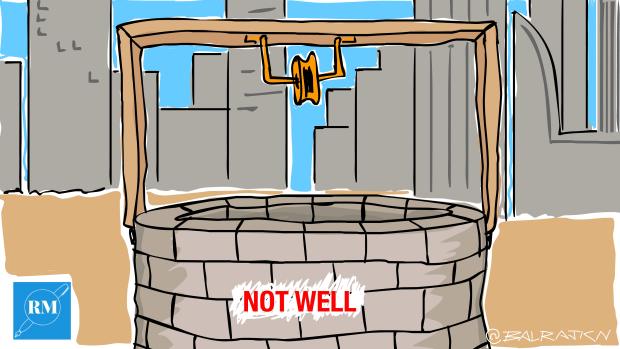
Cartoon : Balraj K N
The floods of 2015 in Chennai, Tamil Nadu, bought the entire city to a stand still. Many were left stranded in their homes and offices for almost three weeks. Nearly 370 lives were lost and an estimated 50 crores worth of property was damaged. Severe rains in a short span of time had resulted in flooding. This washed off more domestic sewage into the Adyar river that is home to nearly 0.98 million people, and is one of the two heavily polluted rivers in Chennai.
Apart from the monumental loss to lives and property, groundwater contamination is one of the long-term impacts of floods. In a recently published study, a team of scientists has studied how badly the groundwater in Chennai was contaminated since the river water inundated wells during floods. This study, published in the journal Scientific Data and funded by the Department of Science and Technology, Government of India, included researchers from Anna University in Chennai, University of Zululand in South Africa, and the National University of Singapore.
“We wanted to know if the city water met the water quality parameters laid down by the Bureau of Indian Standards during and post floods”, says Prof. Lakshmanan Elango at the Department of Geology, Anna University and a co-author of the study. The researchers collected samples at 17 locations along the Adyar river, starting around the Chembarambakkam lake, where the Adyar river originates, up to the seacoast where it finally flows into the Bay of Bengal. The samples were collected on 30th of December 2015 -- two weeks after the floods, and then again on 3rd April 2016 -- 3 months after the floods.
“This would help authorities to take necessary steps to treat water and prevent water-borne diseases like cholera and typhoid, and vector-borne ailments such as dengue, malaria, and encephalitis, from occurring in the future”, adds Prof. Elango, describing the importance of the study. The collected samples were tested for salt and heavy metal concentration, pH, and microbial contents and their susceptibility to available antibiotics. “This information would help assess the effect of floods on the ground water quality of this region”, says Prof. Elango.
The groundwater collection sites were at least a few hundred meters away from dairy farms, garbage bins, septic tanks, and other sources of microbial contamination. The samples were brought to the lab where tests for salts like carbonates, bicarbonates, potassium, calcium, chlorine, magnesium, sodium and sulphate were done. In addition, the samples were screened for heavy metals like aluminum, boron, cadmium, nickel, lead, zinc, chromium, iron, manganese, phosphorus, copper, and lithium.
The water samples were also cultured on a suitable medium to determine the presence of microbes such as Enterobacter, Staphylococcus, Escherichia, Streptococcus, Vibrio, and Salmonella, that are known to cause infections like diarrhoea, dysentery, cholera, and typhoid in humans. These cultures were treated with different doses of antibiotics like ceftriaxone, chloramphenicol, doxycycline, tetracycline, ciprofloxacin, norfloxacin and nalidixic acid, which are routinely used by doctors to treat life-threatening infections.
The scientists found that the groundwater quality post flood had deteriorated considerably. The heavy metal concentration and the microbial load were high compared to the pre-flood levels. They also found that some bacteria that they tested had developed antibiotic resistance. “The bacteria were sensitive to most antibiotics, but some were resistant to nalidixic acid, which was alarming as antibiotic resistance can rapidly spread in the environment”, remarks Prof. Elango about the findings.
The study also showed that bacteria from various sources were more than 99.5% similar in their genetic sequence. “This implied that they must have originated from a single domestic sewage source containing fecal matter. Sewage must have washed off with flood water, which in turn inundated the wells that would have resulted in contaminating the groundwater”, believes Prof. Elango, indicating the potential of such events to impact the microbial quality of groundwater in affected areas for a long time. As the study found, the groundwater quality when re-evaluated in April 2016, was still unsafe for consumption.
The study contributes to our understanding and managing of urban floods, a possibly common phenomenon in the years to come, thanks to climate change and shortcomings of the existing infrastructure. In this backdrop, Prof. Elango shares some advice on how municipal authorities in flood-affected areas could mitigate health hazards -- “The wells must be chlorinated and the public must be warned against consuming groundwater for drinking, at least for some months post floods.”
The researchers plan to conduct these tests again to check on the quality of groundwater. “Since chlorination was done by the city authorities post floods, we are now planning to retest the groundwater in November this year to see what the present status is”, signs off Prof. Elango.






